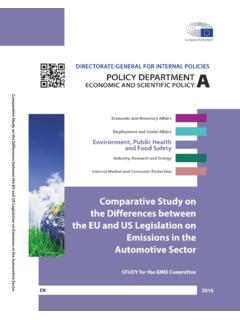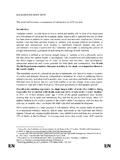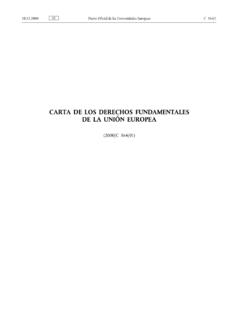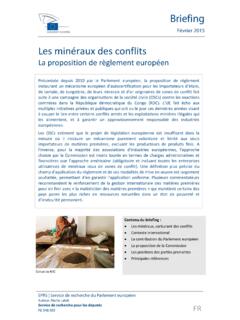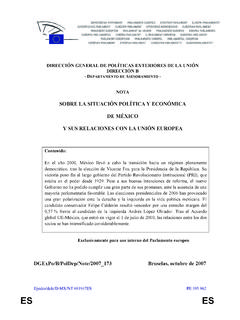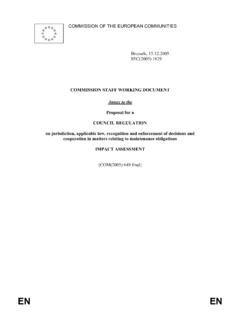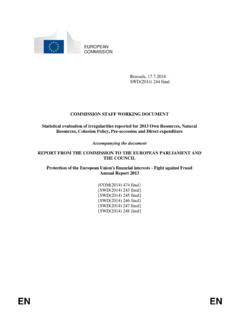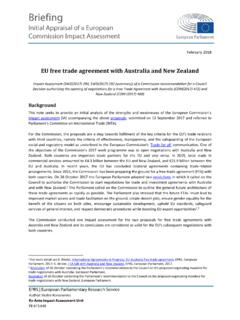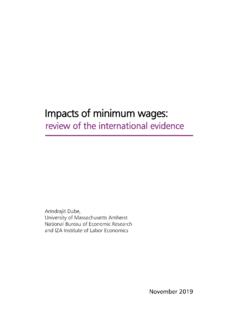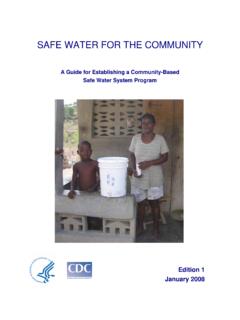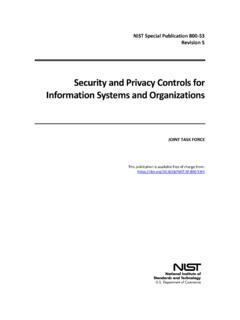Transcription of The precautionary principle - European Parliament
1 IN-DEPTH ANALYSISEPRS | European Parliamentary Research ServiceAuthor:Didier BourguignonMembers' Research ServiceDecember2015 PE ( )TheprecautionaryprincipleDefinitions, applications andgovernanceThis publication takes stock of the debate and questionssurrounding the precautionary principle inthe European Union. It looks at different interpretations of the precautionary principle , references toit in international treaties on environmental protection, definitions developed by different institutions,aswell as related European and international case law.
2 It presents conflicting viewpoints on theprecautionary principle and the arguments used to support them. The publication then studies howthe precautionary principle is applied, setting out practical examples and the main challenges andopportunities it presents. Finally, the publication gives an overview of certain aspects of governanceand the precautionary principle , namely risk governance, the science-policy interface and the linksbetween precaution and 978-92-823-8480-0 French manuscript completed in December completed in February content of this documentis the sole responsibility of the author and any opinionsexpressed therein do not necessarily represent the official position of the European is addressed to the Members and staff of the EP for their parliamentary work.
3 Reproductionand translation for non-commercial purposes are authorised, provided the source isacknowledged and the European Parliament is given prior notice and sent a copy. European Union, credits: frank peters/ precautionary principlePage1of25 EXECUTIVE SUMMARYThe precautionary principle enables decision-makers to adopt precautionary measureswhen scientificevidence about an environmental or human health hazard is uncertainand the stakes are first emerged during the 1970s in German law and has since been endorsed by theinternational community in a number of environmental treaties and by the EU in theMaastricht Treaty.
4 It has also been recognised in the national legislation of certainMember precautionary principle divides opinions. Some see it as a pointless and potentiallydangerous principle that hinders progress. Others believe thatit helps protect humanhealth and the environment from complex is no universally accepted definition of the precautionary mainly vary according to the degree of scientific uncertainty that couldprompt action by the authorities. The European Commission, UNESCO and theEuropean Environment Agency have each put forward their own , the European Court of Justice has contributed to its interpretation andthe extension of its applicationof the precautionary principle is also subject to differentinterpretations.
5 Most experts agree that the precautionary principle does not call forspecific measures such as bans or reversing the burden of proof. However, experts andinstitutions do not agree on the method for determining when to apply precautionarymeasures (cost-benefit analysis, risk trade-off analysis, cost-effectiveness analysis, prosand cons analysis of action and inaction, etc.). Examples of the application of theprecautionary principle include declining bee populations, climate change, fish-stockmanagement, genetically modified organisms or the use of antimicrobials as application of the precautionary principle presents many challenges, especiallywith regardto the treatment of complexity, hazard assessment, research and economicactivities.
6 However, it also presents opportunities, mainly regarding the possibility ofreducing the overall costs of environmental and health research for precautionaryprinciple is closely linked to governance. It raises a number ofquestions regarding risk governance (risk assessment, management andcommunication). Furthermore, since precautionary measures are usually appliedfollowing a political decision based on scientific knowledge, science-policy interfacesare particularly important.
7 Since they are extremely diverse, these interfaces areconfronted with several challenges. Finally, there is considerable debate about the linkbetween precaution and innovation. Theconcept of 'responsible research andinnovation', which is enshrined in the Horizon 2020 European research frameworkprogramme, seeks to reconcile these two precautionary principlePage2of25 TABLE OF CONTENTS1. Defining the precautionary Main interpretations of the precautionary The positions of different European European Environment Case Conflicting A pointless and potentially dangerous A useful principle for averting complex Applying the precautionary Possible precautionary Examples of the precautionary principle 's Challenges and Risk Precaution and Main precautionary principlePage3of25 GlossaryAmbiguity.
8 A situation where the risks are recognised as inherently multifaceted and opinionis divided on the magnitude, characterisation and prioritisation of these method:a statistical inference method based on assessing the probability of ahypothesis, prior to observing a random analysis: this compares the losses (monetary value) and costs of plannedmeasures in order to ensure that the benefits outweigh the analysis: this involves three steps, namely to a) establish an acceptablelevel of risk at policy level, based on scientific evidence; b) decide how to meet this constraintat minimum cost.
9 And c) find out whether the objective is politically : European Environment : Genetically Modified : all actions, processes, traditions and institutions involved in the exercise ofauthority, decision-making and : situation or risk that a substance or technology, by reason of its inherentcharacteristics or properties, could under specific conditions of exposure endanger people,property or the : International Agency for Research on Cancer (agency ofthe World Health Organization).Ignorance: a situation where the environmental and/or health impacts are unknown, with theresult that the probabilities are also unknown.
10 May lead to precautionary measures tominimise the impact of : Intergovernmental Panel on Climate Change set up by the United Nations EnvironmentProgramme and the World Meteorological : International Risk Governance Council, an independent non-profit : protection measures to reduce the risk of a situation with known environmentaland/or health impacts and : likelihood of an adverse event occurring because a hazard coincides with exposure tothat : science-policy : a situationwhere environmental and/or human health impacts are likely but theprobabilities are unknown; may lead to precautionary measures to reduce exposure to : United Nations Framework Convention on Climate : World Trade precautionary in the age of the 'risk society', as defined by the sociologist Ulrich Beck1, createssituations that confront societies with new hazards for people, communities and theirenvironment.
